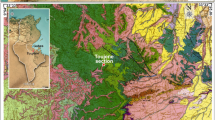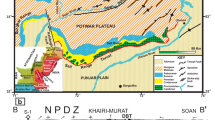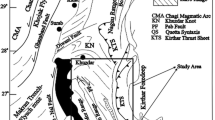Summary
The Middle-Upper Jurassic section in the Arabian Gulf basin forms one of the most prolific sequences in the world, in which an excellent combination of source, reservoir and seal rocks was developed within a major sedimentary cycle. The sequence consists of a) relatively quiet deep-water mudstone, wackestone and shale (source facies), b) shallow-water high enery grainstone and packstone (reservoir facies), and c) very shallow supratidal anhydrite (seal facies). The principal factors, which controlled the sedimentation of this sequence, are considered to have been eustatic sea-level change and epeirogenic movement of carbonate shelves.
The Jurassic reservoirs of the major oil fields in this region show exceptionally high porosity up to 30% for their relatively old geologic age (some 150 million years old) and depths of burial in the range between 1,200 and more than 2,700 m. Porosity occurs most commonly as intergranular/remnant primary pore spaces, but its distribution is quite uneven and very complicated. To account for the existence of such high porosity (and permeability) in the Jurassic reservoirs, probable geological, physical and chemical factors for preserving and enhancing porosity (and permeability), such as acidic formation fluids, reduced fluid mobility, tectonic forces, ductility of intercalated beds (e.g. anhydrite), and dolomitization were examined.
It has been observed in various fields in the region that oilsaturated portions of the Jurassic reservoirs tend to retain higher porosity than the surrounding water-saturated zones. Porosity preservation by hydrocarbons is possible primarily because of excess hydrocarbon pressure and of reduced mobility of water in such oil-saturated zones. To continue sediment diagenesis, a steady supply of minerals by formation water and the mobility of the water may have been essential. Because the entrapment of oil in the Jurassic reservoirs in the region is considered to have been as late as early Tertiary, some other (pre-migration) mechanisms which may have worked in the earlier geologic stages for preserving and creating porosity (and permeability) seem to be necessary.
Similar content being viewed by others
References
Alsharhan, A.S. (1989): Petroleum Geology of the United Arab Emirates.—J. Petrol. Geol.12, 253–288
Alsharhan, A.S., &Kendall, C.G.St.C. (1986): Precambrian to Jurassic rocks of the Arabian Gulf and Adjacent Areas; their facies, depositional setting and hydrocarbon habita.—Amer. Assoc. Petrol. Geol. Bull.70, 977–1002, Tulsa
Alsharhan, A.S. &Nairn, A.E.M. (1994): Geology and hydrocarbon habitat in the Arabian Basin: the Mesozoic of the State of Qatar.—Geol. Mijnb.72, 265–294, Dordrecht.
Alsharhan, A.S. & Magara, K. (in press): The Jurassic of the Arabian Gulf Basin: Their Facies, Depositional Setting and Hydrocarbon Habitat.—In:Embry, A.F. (ed.): Pangea: Global environments and resources.—Can. Soc. Petrol. Geol. Mem.17
Arabian-American Oil Company Staffr (1959): Ghawar Oil Field, Saudi Arabia.—Amer. Assoc. Petrol. Geol. Bull.43, 434–454, Tulsa
Ayres, G., Bilal, M., Jones, R.W., Slentz, L.W., Tartir, M. &Wilson, A.O. (1982): Hydrocarbon habitat in main producing areas, Saudi Arabia.—Amer. Assoc. Petrol. Geol. Bull.66, 1–9, Tulsa
Baria, L.R., Stoudt, D.L., Harris, P.M. &Crevello, P.D. (1982): Upper Jurassic reefs of Smackover Formation, United States Gulf Coast.—Amer. Assoc. Petrol. Geol. Bull.66, 1449–1482, Tulsa
Bashbush, J.L., Savage, W.K., Nagai, R.B., Tadao, O., Wakamiya, J., &Takizawa, H. (1983): A reservoir optimization study-El Bunduq Field, Abu Dhabi, Qatar.—Soc. Petrol. Engrs. (SPE)11481, 323–333.
Beydoun, Z.R. (1988): The Middle East: Regional Geology and Petroleum Resources.—292 pp., Beaconsfield (Scientific Press)
Beydoun, Z.R., Hughes Clark, M.W. & Stoneley, R. (1992): Petroleum in the Zagros basin; A late Tertiary foreland basin overprinted onto the outer edge of a vast hydrocarbon-rich Paleozoic-Mesozoic passive-margin shelf.—In:Macqueen, R.W. & Lecki, D.A. (eds.): Foreland Basins and Fold Belts-Amer. Assoc. Petrol. Geol. Mem.55, 309–339, Tulsa
Broomhall, R.W., &Allan, J.R. (1985): Regional Caprockdestryoing dolomite on the Middle Jurassic to Early Cretaceous Arabian Shelf.—4th Middle East Oil Show, Bahrain, Soc. Petrol. Engrs. (SPE)13697 157–164
Choquette, P.W. &Pray, L.C. (1970): Geologic nomenclature and classification of porosity in sedimentary carbonates.—Amer. Assoc. Petrol. Geol. Bull.54, 107–250, Tulsa
Crevello,P.D.,Harris,P.M.,Stoudt,D.L. &Baria,L. (1985): Porosity Evolution and Burial Diagenesis in a Jurassic Reef-Debris Reservoir, Smackover Formation, Hico Knowles Field, Louisiana.—In:Roehl,P.O. &Choquette,P.W. (eds.): Carbonate Petroleum Reservoirs.—385-406, Berlin (Springer)
Dunnington H.V. (1967): Aspects of diagenesis and shape change in stylolitic limestone reservoirs.—7th World Petrol. Congr. Mexico, 339–352
Enos, P. &Sawatsky, L.H. (1981): Pore networks in Holocene carbonate sediments—J. Sed. Petrol.51, 961–985, Tulsa
Grover, G.A. Jr. (1993): Abquaiq Hanifa Reservoir: Geologic attributes controlling hydrocarbon production and water injection. —8th Middle East Oil Technical Conference & Exhbition, Bahrain, Soc. Petrol. Engrs. (SPE)25607, 113–118
Halley, R.B. &Schmoker, J.W. (1983): High porosity Cenozoic carbonate rocks of south Florida: Progressive loss of porosity with depth.—Amer. Assoc. Petrol. Geol. Bull.67, 191–200, Tulsa
Harris, P.M., Kendall, C.G.St.C. & Lerche, I. (1985): Carbonate cementation −A brief review.—In:Schneidermann N. & Harris, P.M. (eds.): Carbonate cements.—Soc. Econ. Paleont. Min., Spec. Publ.,36, 79–95, Tulsa
Higuchi, Y. (1992): Considerations on the mechanism of petroleum accumulation in the southern Persian Gulf area (Part 1). —J. Jap. Assoc. Petrol. Tech.57, 264–273, Tokyo
Hosoi, H. (1989): Umm Al Dalkh and Satah oil fields exploration and development.—J. Jap. Assoc. Petrol. Techn.54, 152–159
Kompanik, G.S., Heil, R.J., Al Shammari, Z.A. &Al Shammery, M.J. (1993): Geologic modelling for reservoir simulation: Hanifa Reservoir, Berri Field, Saudi Arabia.—8th Meddle East Oil Technical Conference & Exhbition., Bahrain.—Soc. Petrol. Engrs. (SPE)25580, 517–531
Koop, W.J. & Stoneley R. (1982): Subsidence history of the Middle East Zagros Basin, Permian to Recent.—In:Kent, P. et al. (eds.): The evolution of sedimentary basins.—Phil. Trans. Roy. Soc. Lond. Series A,305, 149–168
Langton, J.R. &Chin, G.E. (1968): Rainbow Member facies and related reservoir properties. Rainbow Lake, Alberta.—Bull. Can. Petrol. Geol.16, 104–143, Calgary
Magara, K., Khan, M.S., Sharief, F.A. &Al-Khatib, H.N. (1993): Log-derived reservoir properties and porosity preservation of Upper Jurassic Arab formation in Saudi Arabia.—Mar. Petrol. Geol.10, 352–363
Mitchell, J.C., Lehmann, P.J., Cantrell, D.L., Al-Jallal, I.A. & Al Thagafy, M.A.R. (1988): Lithofacies, Diagenesis and Depositional Sequence; Arab-D Member, Ghawar Field, Saudi Arabia.—In:Lomando, A.J. & Harris, P.M. (eds.): Giant Oil and Gas Fields.—Soc. Econ. Paleont. Min. Core Workshop12/ 2, 459–514, Tulsa
Moore, C.H. &Druckman, Y. (1981): Burial diagenesis and porosity evolution, Upper Jurassic Smackover, Arkansas and Louisiana.—Amer. Assoc. Petrol. Geol. Bull.65, 597–628, Tulsa
Munn D. & Jubralla, A. (1987): Reservoir geological modelling of the Arab D reservoir in the Bul Hanine, Offshore, Qatar—Approach and Results.—5th Middle East Oil Show, Soc. Petrol. Engrs. (SPE)-15699
Murris, R.J. (1980): Middle East:Stratigraphic evolution and oil habita.—Amer. Assoc. Petrol. Geol. Bull.64, 597–618, Tulsa
Powers, R.W. (1962): Arabian Upper Jurassic carbonate reservoir rocks.—In:Ham, W.E. (ed.): Classification of Carbonate Rocks.—Amer. Assoc. Petrol. Geol. Bull.1, 122–197, Tulsa
Powers, R.W., Ramirez, C.D, Redmond &Elberg, E.L. Jr. (1966): Geology of the Arabian Peninsula, Sedimentary Geology of Saudi Arabia.—U.S. Geol. Survey, Prof. Paper,560-D, 127 p
Pratt, B.R. (1982): Limestone response to stress-pressure solution and dolomitization—Discussion and examples of compaction in carbonate sediments.—J. Sed. Petrol.52, 323–328, Tulsa
Purser, B.H. (1978): Early diagenesis and the preservation of porosity in Jurassic limestones.—J. Petrol. Geol.1, 83–94
Roehl, P.O. (1967): Stony Mountain (Ordovician) and Interlake (Silurian) facies analogs of Recen low-energy marine and subaerial carbonates, Bahamas.—Amer. Assoc. Petrol. Geol. Bull.51, 1979–2032, Tulsa
Shinn, E.A., Halley, R.B., Hudson, J.H. &Lidz, B.H. (1977): Limestone compaction—An enigma.—Geology,5, 1–24
Stoneley R. (1987): A review of Petroleum source rocks in parts of the Middle East.—In:Brooks & Fleet, (eds.): Marine Petroleum Source Rocks.—Geol. Soc. Spec. Publ.26, 263–269
Sugden, W. & Standring, A.J. (1975): Qatar Peninsula.—Lexique Strat. Internat., Centre Nat. Rech. Scient. Paris,111, Asie, fasc. 10b3, 120 pp.
Surdam, R.C., Crossey, L.J., Hagan, E.S. &Heasler, H.R. (1989): Organic-in organic interactions and sandstone diagenesis.— Amer. Assoc. Petrol. Geol. Bull.73, 1–23, Tulsa
Suzuki M. &Ohsawa, M. (1987): Sedimentary facies in the Arab formation offshore Abu Dhabi, U.A.E.—J. Jap. Assoc. Petrol. Tech.52, 124–133, Tokyo
Tillman, J.E. (1983): Exploration for reservoirs with fracture-enhanced permeability.—Oil and Gas Jour., Feb. 21, 165–179
van der Bark, E. &Thomas, O.D. (1981): Ekofisk: First of the gian oil fields in western Europe.—Amer. Assoc. Petrol. Geol. Bull.65, 2341–2363, Tulsa
Wanless, H.R. (1979): Limestone response to stress: Pressure solution and dolomitization.—J. Sed. Petrol.49, 437–462, Tulsa
Wilson, A.O. (1981): Jurassic Arab-C and D Carbonate Petroleum reservoirs Qatif Field, Saudi.—2nd Middle East Oil Show, Bahrain. Soc. Petrol. Engrs. (SPE)9494, 171–177
Wilson,A.O. (1985): Depositional and diagenetic facies in Jurassic Arab C and D reservoirs, Qatif field, Saudi Arabia.—In:Roehl,P.O. &Choquette,P.W. (eds.): Carbonate Petroleum Reservoirs.— 319-340, New York (Springer)
Author information
Authors and Affiliations
Rights and permissions
About this article
Cite this article
Alsharhan, A.S., Magara, K. Nature and distribution of porosity and permeability in jurassic carbonate reservoirs of the Arabian Gulf basin. Facies 32, 237–253 (1995). https://doi.org/10.1007/BF02536872
Received:
Accepted:
Issue Date:
DOI: https://doi.org/10.1007/BF02536872




